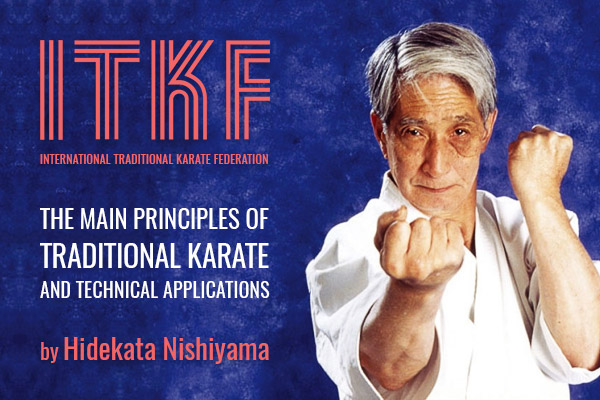Main Principles of Traditional Karate and technical applications
by Hidetaka NISHIYAMA - septembrie 2001

In documentul prezentat, Principii de Karate Traditional si aplicatii tehnice de Karate - "Main Principles of Traditional Karate and technical applications by Hidetaka NISHIYAMA" publicat in 2001, am pastrat limba originala in care a fost publicat documentul pentru a transmite cat mai corect nuantele si intelesul acestuia.
MAIN PRINCIPLES OF TRADITIONAL KARATE AND TECHNICAL APPLICATIONS
by Hidetaka NISHIYAMA / ITKF - september 2001
SUMMARY:
PART 1: MAIN PRINCIPLES OF KATA and Applications to Techniques
Posture
Keep the body's axis extended through the body's center of gravity and further extended through the supporting surface.
* The maintaining of this body alignment perpendicular to the floor provides the most efficient body control.
MESEN (eye line)
Maintain direct line connection from face and eyes toward the opponent.
* This provides most efficient means of directing body movement.
Stable Emotions
* Provides for smooth body movement, clear decision-making and proper reaction
Charging Body with KI Power
* Develops energy for movement and acceleration as well as overcoming opponent.
Muscle Control Through Proper Breathing
The means by which maximum power can be delivered by one's muscles
APPLYING PRINCIPLES TO TECHNIQUES
Condition of TACHI (Stance)
PART 2: MAIN PRINCIPLES OF BUDO
KAKE WAZA (charging without opponent's attack)
Executing technique at the instant of detecting opponent's KYO
OJI WAZA (response to opponent's attack)
During opponent's attack, detecting kyo and executing counter technique.
SEN (start of opponent's attack)
Catching opponent in state of "Kyo" at the initiation of attack.
KAKE no SEN (pre-physical movement)
Executing technique upon sensing opponent's mental commiment just before initiating his attack.
TAI no SEN (physical movement)
Executing technique when detecting KYO upon opponent's initial physical movement to attack.
GO no SEN (after opponent's attack)
Executing technique end of opponent's attack in between attacking techniques or catching and blocking initial attack before next attack begins.
SHIKAKE WAZA ("Set-up" techniques)
Making KYO without waiting for opponent's movement. There are 3 basic types:
SASOI WAZA ("Inviting" technique)
Then use "Sen" or Sen'' timing to counter
KUZUSHI WAZA (breaking balance technique)
Breaking balance by sweeping foot, etc., making KYO, followed by finishing technique.
RENZOKU KOGEKI WAZA (continuing attack technique)
Making KYO by breaking opponent's mental and physical balance with continuous attacks.
ITKF - "Main Principles of Traditional Karate and technical applications" by Hidetaka NISHIYAMA, september 2001
Alege clubul cu care dorești să intri în contact sau discută direct cu Federația Română de Karate Tradițional.
Înscrie-ți clubul pe Harta Karate-ului Tradițional din România. Clubul trebuie să fie acreditat și afiliat FRKT/ETFK/ITKF.
Trimite-ne un eveniment, antrenament sau articol despre Karate Tradițional și noi îl vom publica.
Dacă ai nevoie de ajutor nu ezita să ne contactezi.